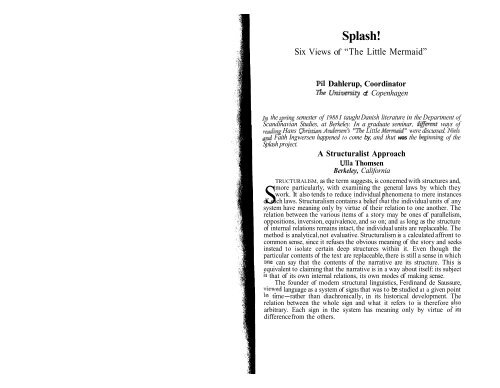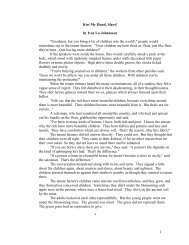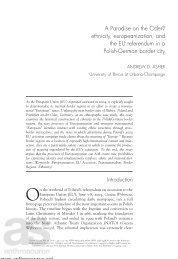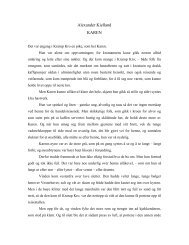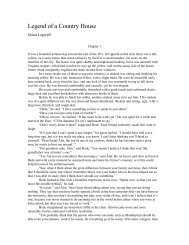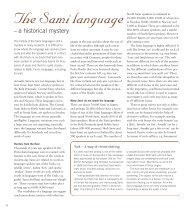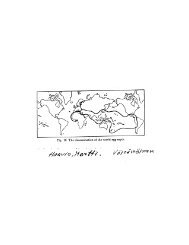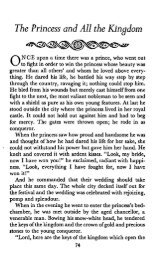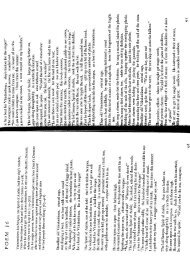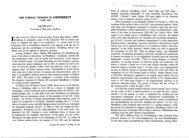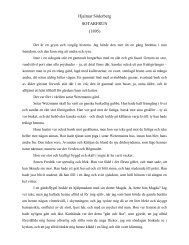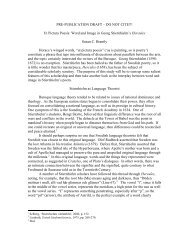Six Views of “The Little Mermaid” - Department of Scandinavian ...
Six Views of “The Little Mermaid” - Department of Scandinavian ...
Six Views of “The Little Mermaid” - Department of Scandinavian ...
Create successful ePaper yourself
Turn your PDF publications into a flip-book with our unique Google optimized e-Paper software.
Splash!<br />
<strong>Six</strong> <strong>Views</strong> <strong>of</strong> <strong>“The</strong> <strong>Little</strong> <strong>Mermaid”</strong><br />
Pi1 Dahlerup, Coordinator<br />
The University <strong>of</strong> Copenhagen<br />
In the sp’ng semester <strong>of</strong> 1988 I taught Danish literature in the <strong>Department</strong> <strong>of</strong><br />
<strong>Scandinavian</strong> Studies, at Berkeley. In a graduate seminar, dzffeent ways <strong>of</strong><br />
reding Hans Gristian Andenen’s “i%e <strong>Little</strong> Mermid” were discussed. Niels<br />
and Faith Ingwersen happened to come by, and thut was the begtnning <strong>of</strong> the<br />
Splash project.<br />
A Structuralist Approach<br />
Ulla Thomsen<br />
Berkeley, California<br />
TRUCTURALISM, as the term suggests, is concerned with structures and,<br />
more particularly, with examining the general laws by which they<br />
work. It also tends to reduce individual henomena to mere instances<br />
S <strong>of</strong> such laws. Structuralism contains a belief t R at the individual units <strong>of</strong> any<br />
system have meaning only by virtue <strong>of</strong> their relation to one another. The<br />
relation between the various items <strong>of</strong> a story may be ones <strong>of</strong> parallelism,<br />
oppositions, inversion, equivalence, and so on; and as long as the structure<br />
<strong>of</strong> internal relations remains intact, the individual units are replaceable. The<br />
method is analytical, not evaluative. Structuralism is a calculated affront to<br />
common sense, since it refuses the obvious meaning <strong>of</strong> the story and seeks<br />
instead to isolate certain deep structures within it. Even though the<br />
particular contents <strong>of</strong> the text are replaceable, there is still a sense in which<br />
one can say that the contents <strong>of</strong> the narrative are its structure. This is<br />
equivalent to claiming that the narrative is in a way about itself: its subject<br />
is that <strong>of</strong> its own internal relations, its own modes <strong>of</strong> making sense.<br />
The founder <strong>of</strong> modem structural linguistics, Ferdinand de Saussure,<br />
yiewed language as a system <strong>of</strong> signs that was to be studied at a given point<br />
time-rather than diachronically, in its historical development. The<br />
relation between the whole sign and what it refers to is therefore also<br />
arbitrary. Each sign in the system has meaning only by virtue <strong>of</strong> Its<br />
difference from the others.
14L 3LANUIIYAVIAIY 3 1 UlJIILa<br />
The modern structural analysis <strong>of</strong> narrative, the science <strong>of</strong> narratology,<br />
began with the work on myth by Claude Levi-Strauss, who viewed<br />
apparently different myths as variations on a number <strong>of</strong> basic themes.<br />
Although Vladimir Prop had in 1928 reduced all folk tales to seven spheres<br />
<strong>of</strong> action and thirty-one P ixed elements <strong>of</strong> functions, A. J. Greimas was able<br />
to abstract his account even further by the concept <strong>of</strong> an “actant,” which<br />
is neither a specific narrative event nor a character, but a structural unit.<br />
Not only does structuralism think everything through again, this time as<br />
language, but it thinks everything through again as though language were<br />
its Gee subject matter.<br />
Structuralism has led to the creation <strong>of</strong> some simple interpretive models<br />
that are Dart <strong>of</strong> a descriptive method, and in the following I will apply these<br />
models ;o <strong>“The</strong> <strong>Little</strong> Mermaid.”<br />
The <strong>Little</strong> Mermaid<br />
The text features a sequence <strong>of</strong> events experienced by the little mermaid. In<br />
order to carry out her wishes to become 1. a human being, 2. to marry the<br />
prince, and 3. to achieve immortality, certain preconditions have to be<br />
satisfied. The mermaid’s will to achieve her goals is unim aired throughout<br />
, but her will is not enough; she needs help P rom the witch to<br />
“‘“31<br />
the realize t em. The price for this help is high; she has to suffer a lot <strong>of</strong> pain<br />
and the loss <strong>of</strong> her beautiful voice. When it becomes clear to the mermaid<br />
that the prince is not going to marry her (and hereby give her an immortal<br />
soul), she decides not to save herself by taking the life <strong>of</strong> the prince.<br />
Through self-sacrifice there is the possibility <strong>of</strong> her achieving immortality<br />
within the next 300 years.<br />
The Actantial Model<br />
The actantial model shows a static picture, a chart <strong>of</strong> the project and its<br />
conditions. It does not inform the reader how the enterprise progresses. If<br />
the subject is a prince and the object a princess he wants to marry, he is the<br />
receiver regardless <strong>of</strong> the success <strong>of</strong> his project. Just as the king is the sender,<br />
even though he might not give the princess to the prince. As above<br />
mentioned, the mermaid has three wishes, and it is therefore necessary to<br />
apply three actantial models.<br />
1. The subject is the mermaid; she wants to become human (object).<br />
Her helper is the sea witch, the opponents her mermaid body. The<br />
sender is the witch, and the receiver is the mermaid.<br />
2. The subject is the mermaid; she wants to marry the prince (object).<br />
She has no helper, and the loss <strong>of</strong> her voice is her opponent. The sender<br />
is the prince, and the mermaid the receiver.<br />
SPLASH! 143<br />
3. The mermaid is the subject, immortality the object. Her own good<br />
deeds are her helpers. The prince’s marrying the princess is her<br />
opponent. God is the sender, and the mermaid is the receiver.<br />
Through the three models one can see that the mermaid within her<br />
own environment is able by her actions to obtain help to carry out her<br />
project. In the human world she is at first passive and remains without a<br />
helper. It is only when she decides to act (not to kill the prince) that she is<br />
helped to achieve her goal <strong>of</strong> immortality.<br />
The Contract Model<br />
In the contract model the progress <strong>of</strong> the story is described. The contract<br />
can be informal and consist, for example, <strong>of</strong> a congenial acce tance, <strong>of</strong> the<br />
norms <strong>of</strong> a certain milieu, family, village, or nation. The m el shows that<br />
the principal character-the mermaid-at the beginning is o f<br />
relationship, which she breaks. She goes against her family and the rules set<br />
by nature. By breaking the contract, she is ostracized from the community<br />
and is moved to a world with other rules. The mermaid is not able to<br />
achieve her goal <strong>of</strong> physical and s iritual love in this new world, but by<br />
killing the prince, she will be abe to reestablish the contract with her<br />
r<br />
B<br />
family. However, she does not choose to do so; instead, she decides to take<br />
her own life. She thereb obtains the status <strong>of</strong> a martyr; she is then moved<br />
to a third world, that o the daughters <strong>of</strong> the air.<br />
From the be inning <strong>of</strong> the story such a development has been hinted<br />
at. The mermai comes from a world where the sea king is merely a<br />
figurehead. The B sea witch has the real power. She represents raw power,<br />
know-how <strong>of</strong> a frightening character, and she is old, ugly, and destructive.<br />
The mermaid is far too good to return to the sea witch’s world. She is<br />
young, beautiful, brave, modest, faithful, active, and-above all-different.<br />
The prince is also young and handsome, but he is self-centered, egoistic, and<br />
passive. He is not worthy <strong>of</strong> the mermaid.<br />
The S-model<br />
The following represents the binary oppositions that form the basic dualism<br />
in the beginning <strong>of</strong> the story.<br />
Universal Order<br />
Order in the Sea<br />
Order in the Land<br />
Mortality Immortality<br />
Lower world Higher world<br />
Lack <strong>of</strong> ability to cry Ability to cry<br />
Me r-people Human beings<br />
Nature Culture<br />
in a contract-
144 SCANDINAVIAN 3 1 U UICS<br />
Girlhood<br />
Childhood<br />
No fragrance<br />
No sexuality’<br />
Femininity<br />
Womanhood<br />
Adulthood<br />
Fragrance<br />
Sexuality<br />
Masculinity<br />
The movement between the binary oppositions in the text can be<br />
illustrated as follows:<br />
Lfe in the Sea World, .<br />
’+Life in the Land World’<br />
The following represents the binary oppositions that form the basic dualism<br />
at the end <strong>of</strong> the story.<br />
Univmd Order<br />
Order <strong>of</strong> the Humans Order <strong>of</strong> the Air Spirits<br />
Innate immortality Acquired immortality<br />
Higher World Highest World<br />
Humans Air spirits<br />
Sexuality Spirituality<br />
Fragrance Distributor <strong>of</strong> Fragrance<br />
No demands Demands<br />
Masculinity Femininity<br />
The movement between the binary oppositions can be illustrated as follows:<br />
Life <strong>of</strong> Humuns \<br />
\<br />
Immortal Life’<br />
A<br />
I<br />
I<br />
Life <strong>of</strong> the Aii Spirits<br />
The model asserts that a movement between two conditions always<br />
takes place in two phases. First one movement that removes or negates the<br />
first condition, hereafter a movement that establishes another condition.<br />
Conclusion<br />
Structuralism is very goal-directed; it takes a direct approach to unveil the<br />
central meaning and structure <strong>of</strong> a text.<br />
In the actantial model the enterprise <strong>of</strong> the mermaid is pointed out and<br />
the forces working for her and against her are clarified. The contract model<br />
highlights the process <strong>of</strong> the story from the beginning to the very end. The<br />
S-model focuses on the two possible conditions that the sto relates to and<br />
tells about: mortality versus immortality. We have moved 7 rom a cause <strong>of</strong><br />
>PLASH! 145<br />
events <strong>of</strong> a more or less manifold character to some hidden law that can be<br />
captured in simple models. The argument can therefore be made that this<br />
story has a world view that is based on binary oppositions.<br />
Notes<br />
’ This is how I interpret fish tails versus legs.<br />
* The line is broken because the mermaid does not succeed in achieving human life.<br />
’ The line is broken because we do not know within the framework <strong>of</strong> the story whether<br />
or not the mermaid achieves immortality.<br />
A Psychoanalytic Approach<br />
Sabrina Soracco<br />
Berkeley, California<br />
TRADITIONAL psychoanalytic approach to a literary text employs the<br />
tenets <strong>of</strong> classical psychoanalysis, developed by Freud and further<br />
A elaborated on, and modified by, his followers. One <strong>of</strong> the more<br />
significant aspects <strong>of</strong> Freudian theory and that which has come under<br />
greatest critique from post-Freudian feminist psychoanalytic theory is<br />
Freud’s notion <strong>of</strong> the Oedipal complex. The main objection to Freud’s<br />
theories on female psychosexual development, which are outlined in his<br />
three essays “Some Psychical Consequences <strong>of</strong> the Anatomical Distinction<br />
Between the Sexes” (1925), “Female Sexuality” (1931), and “Femininity”<br />
(1933), revolves around Freud’s insistence that women are born physically<br />
castrated. According to Freud, the little girl blames the mother for her own<br />
castration and turns to the father as the person who can provide her with<br />
the phallus she is lacking. Unable to gain access to the father because <strong>of</strong> the<br />
incest taboo, Freud maintains that the female desire for the hallus is<br />
transformed into the desire for a baby, preferably a boy. This Oe ipal crisis<br />
is suppressed during the period <strong>of</strong> latency and reemerges at puberty, B when<br />
the Oedipal desire resurfaces and is displaced from the father onto other<br />
male figures. Post-Freudian object theorists such as Nancy Chodorow would<br />
maintain that it is not only the Oedipal but also the pre-Oedipal conflicts<br />
that reemerge at prepuberty and adolescence and that the adolescent girl,<br />
more so than the boy, must struggle with greater issues <strong>of</strong> separation from<br />
the pre-Oedipal mother. Using a psychoanalytic framework, one might<br />
interpret “Den lille Havfrue” as an attempt on the part <strong>of</strong> the mermaid to<br />
work through the Oedipal conflict characteristic <strong>of</strong> the adolescent phase.<br />
The mermaid’s desire to leave the female dominated mer-world is<br />
already anticipated in her garden, which has as its center a male statue<br />
resembling the prince. The desire <strong>of</strong> the little mermaid to leave the<br />
mer-world, the world <strong>of</strong> the pre-Oedipal mother, dominates the initial part<br />
<strong>of</strong> the story. On her fifteenth birthday, she, like her sisters, travels to see<br />
the human world. While the journey to the higher world satisfies the<br />
-
146 SCANDINAVIAN STUDIES SPLASH! 147<br />
curiosity <strong>of</strong> her older sisters, the little mermaid returns with an intense<br />
desire for the prince and the human patriarchal world. From her grandmother<br />
she learns that human beings have immortal souls and that a<br />
mermaid can acquire one by marrying a human. She then travels to the sea<br />
witch in order to seek her assistance in acquiring a human form. She<br />
willingly sacrifices her voice to the sea witch for the magic potion. The<br />
cutting out <strong>of</strong> the mermaid’s ton e and her simultaneous loss <strong>of</strong> language<br />
r<br />
can be interpreted as a form o castration. Her acceptance <strong>of</strong> her own<br />
castration is in Freudian terms the prerequisite for the phallic desire that she<br />
directs toward the prince. In a Lacanian sense this castration, or lack <strong>of</strong><br />
language, is what will prevent her from participating in the symbolic order.<br />
Thus the mermaid, who had been characterized as being whole and<br />
possessing a beautiful voice in the matriarchal mer-world, enters the<br />
patriarchal human world severely disabled. One might venture to say that<br />
H. C. Andersen’s tale thus thematizes the suppression <strong>of</strong> female and<br />
maternal subjectivity in the patriarchal order. In Freudian terms the girl<br />
blames the mother for her own castration. It is <strong>of</strong> note here that H. C.<br />
Andersen uses a negative female figure, the sea witch, as castrator, thereby<br />
reinforcing the negative image <strong>of</strong> woman as aggressor. One might say that<br />
the sea witch represents the ambivalent mother, who on the one hand<br />
wishes to romote her daughter’s separation, but on the other desires to<br />
keep her c P ose. For, while the sea witch “helps” the little mermaid in her<br />
quest to be human, it is the very nature <strong>of</strong> her assistance that in fact<br />
prevents the success <strong>of</strong> the mermaid’s quest. Without language she cannot<br />
be her own effective agent in the symbolic order. It is also significant that<br />
it is the sea witch who ultimately provides the mermaid with the dagger to<br />
kill the prince, an act which would enable her to return to the pre-Oedipal<br />
realm <strong>of</strong> the mother. Thus, both her encounters with the sea witch, in<br />
effect, prevent the mermaid from successfully working through the Oedipal<br />
crisis: the first by crippling her abilities to succeed in the human order<br />
owing to her loss <strong>of</strong> language and the second by providing her with a<br />
resolution that would return her to the mer-world, a place to which the<br />
mermaid herself has had an ambivalent response. One might say that the<br />
mermaid’s refusal to kill the prince reflects her desire to separate from the<br />
maternal realm and work through the Oedipal crisis, for it seems she would<br />
rather die than return to the mer-world. By refusing to kill the prince and<br />
by directing the dagger toward the sea, the mermaid sacrifices the matriarch-<br />
al order to the atriarchal one. The Oedipal desire <strong>of</strong> the mermaid is<br />
thereby sustainelin the “daughters <strong>of</strong> the air” episode by being displaced<br />
onto patriarchal religion. It is interesting to note that Freud himself sees<br />
religious needs as representing the desire for the protective father. In<br />
Civilization and Its Discontents (1930), Freud writes, <strong>“The</strong> derivation <strong>of</strong><br />
religious needs from the infant’s helplessness and the longing for the father<br />
aroused by it seems to me incontrovertible” (20). This is also supported by<br />
Madelon Sprengnether in her recent book Be S’d Mother (1990), in<br />
which she writes, <strong>“The</strong> theme <strong>of</strong> human helplessness forms a bridge to<br />
Freud’s understanding <strong>of</strong> religion as an expression <strong>of</strong> the desire for paternal<br />
protection” (115).<br />
A Freudian analysis <strong>of</strong> this type reveals the privileged position <strong>of</strong><br />
patriarchal resence inherent in Freud‘s theories. However a feminist<br />
analysis <strong>of</strong>t fl e story might emphasize that the little mermaid has grown up<br />
motherless and that, as the youngest <strong>of</strong> the sisters, has experienced the<br />
shortest bond with the mother. While the story indicates that the grandmother<br />
serves as a mother substitute, the loss incurred by the mermaid <strong>of</strong><br />
her biological mother could be an indication <strong>of</strong> early psychic wounding,<br />
which her subsequent quest attempts to heal.<br />
While Freudian and post-Freudian theories are by far the more<br />
commonly employed modes <strong>of</strong> psychoanalytic interpretation, there are<br />
certain elements in the text that might make a Jungian a proach more<br />
compelling. What first comes to mind in this regard is t g e contrastive<br />
importance <strong>of</strong> religion in Freudian and Jungian thought. Freud relegates<br />
religion to the sphere <strong>of</strong> feeling, as opposed to the realm <strong>of</strong> science, a realm<br />
that Freud privileges. While Freud acknowledges some type <strong>of</strong> religious<br />
sentiment, he does not see it as an organic part <strong>of</strong> the human psyche. In<br />
contrast to Freudian psychoanalysis, Jungian analytical psychology privileges<br />
spirituality and its expression in religious sentiment. Jung sees the spiritual<br />
as primary, an organic part <strong>of</strong> the syche. Thus, one <strong>of</strong> the reasons a<br />
Jungian approach might work more e Ff eaively with “Den lille Havfrue” is<br />
its ability to incorporate better the text’s spiritual as .<br />
Jungian psychology focuses on the concept <strong>of</strong> a w rcts ole psyche composed<br />
<strong>of</strong> various archetypes. Although every individual human psyche possesses<br />
the same archetypes, different archetypes may be rominent at different<br />
times. According to Jung, the psyche also possesses P eminine and masculine<br />
elements:<br />
Jung hypothesized a psychic structure that corresponds to the different<br />
chromosomal makeup <strong>of</strong> men and women: a predominantly feminine<br />
conscious personality in a woman, masculine in a man, together with<br />
a predominantly, masculine or feminine component, respectively, in the<br />
unconscious . . . Each is needed to complement the other, and<br />
therefore, is insufficient alone . . . For a man or woman to achieve<br />
wholeness, it is essential that each develop both the feminine and<br />
masculine sides <strong>of</strong> his or her personality. (Mattoon 83-84)<br />
The balancing <strong>of</strong> the masculine and feminine within one’s psyche is seen<br />
as part <strong>of</strong> the individuation process. This integration <strong>of</strong> all psychic aspects<br />
results in a wholeness the eventual expression <strong>of</strong> which is <strong>of</strong>ten reflected in<br />
the realm <strong>of</strong> spirituality. Using a Jungian interpretation, Eigil Nyborg<br />
interprets “Den lille Havfrue” as a depiction <strong>of</strong> the prince’s individuation
148<br />
SCANDINAVIAN STUDIES<br />
process, with the little mermaid representing his unconscious feminine<br />
element pis anima). Although Nyborg sees the prince as the protagonist <strong>of</strong><br />
the tale, one could argue that the mermaid is the central character and that<br />
the story relates her attempt at individuation, with the prince representing<br />
her animus. Such an interpretation would reveal the mermaid’s failed<br />
attempt at individuation. What thwarts her effort at wholeness is her<br />
repression and eventual annihilation <strong>of</strong> the feminine in an attempt to<br />
integrate the masculine.<br />
The sea world in which the little mermaid lives has the following<br />
qualities: it is female dominated (there is an almost entire absence <strong>of</strong> males);<br />
it is a world <strong>of</strong> death for humans; and its creatures (the mer-folk) tend to<br />
appear and be active at night. The sea, death, and night in Jungian terms are<br />
seen as female symbols. In this seemingly peaceful and contented world, the<br />
little mermaid is, however, unhappy. She longs to ascend to the human<br />
world. Jungian psychology <strong>of</strong>ten interprets the subject’s desire for another<br />
as the subject’s projection <strong>of</strong> hidher animalanimus. For example, the male<br />
subject projects his anima onto the female object, whereas the female subject<br />
projects her animus onto the male object. This projection <strong>of</strong>ten represents<br />
the subject’s desire “for all that one is not, consciously-but may be,<br />
unconsciously” (Singer 205). She yearns for the prince and the sun, which<br />
in Jungian terms is a traditionally male symbol. Indeed, her garden is even<br />
shaped like the sun, composed <strong>of</strong> red flowers (which are reminiscent <strong>of</strong> little<br />
suns) and a statue <strong>of</strong> a boy, which the rince happens to resemble. In<br />
Jungian terms, the strength <strong>of</strong> her desire P or the prince is characteristic <strong>of</strong><br />
the projection <strong>of</strong> the animus onto a male figure: <strong>“The</strong>refore animus and<br />
anima . . . are experienced primarily in a projected form in relationshi s<br />
between the sexes with a special quality <strong>of</strong> strength that transcends near f y<br />
all other human feelings” (Singer 205). The integration <strong>of</strong> masculine and<br />
feminine elements in the psyche is a quest for unity and wholeness. The fact<br />
that the prince and the little mermaid share the same birthday further<br />
emphasizes the possibility that the prince and the little mermaid may be<br />
considered two unintegrated aspects <strong>of</strong> self. The steps necessary to obtain<br />
the prince are, however, those that require the repression <strong>of</strong> the little<br />
mermaid’s own identity, for, by drinking the witch’s potion, she loses both<br />
her mermaid form and her voice. In the penultimate scene, the little<br />
mermaid throws the dagger into the sea, which turns red where the blade<br />
touches it. With this gesture the little mermaid is symbolically killing the<br />
feminine (the sea) with a phallic object (the dagger), representative <strong>of</strong> the<br />
masculine. A further indication that the feminine archetype in this case is<br />
overshadowed and destroyed by the masculine is the fact that the sunbeams<br />
bring death to the little mermaid: “den lille Havfrue lagde sine hvide Arme<br />
paa Reelingen og saae mod 0sten efter Morgenrden, den f~rrste Solstraale,<br />
vidste hun, vilde dmbe hende” [lo51 (the little mermaid leaned her white<br />
arms on the railing and looked eastward toward the red dawn; the first ray<br />
SPLASH! 149<br />
<strong>of</strong> sunlight, she knew, would kill her). Thus the little mermaid’s attempt at<br />
individuation fails. The wholeness and spirituality that result from psychic<br />
integration thus remain that which she still desires in the “daughters <strong>of</strong> the<br />
air” episode.<br />
Whether one takes a Freudian or Jungian approach to this text, what<br />
Seems to be at stake is the thwarted efforts <strong>of</strong> the female figure to develop<br />
and articipate fully in a patriarchal order. While Nyborg takes a psychobiograp<br />
R ical approach, viewing the prince as representing aspects <strong>of</strong> H. C.<br />
Andersen’s own development, one could argue that Andersen’s identification<br />
is instead with the little mermaid. Much like Freud, Andersen seems highly<br />
invested in rojecting his own fear <strong>of</strong> castration, or disempowerment, onto<br />
the female P igure <strong>of</strong> the mermaid. Her castration (loss <strong>of</strong> tongue, voice, and<br />
art) might represent Andersen’s own fear <strong>of</strong> losing his ability to express<br />
himself as an artist. Finally, the mermaid, in her persistent attempt to<br />
transcend her own origins and gain access to another world, might well<br />
reflect H. C. Andersen’s own entrapment in the position <strong>of</strong> outsider.<br />
Works Consulted<br />
Andersen, H. C. Euentyr. Vol. I Fortabfor Bern, 2835-2842. Ed. Erik Dal. Copenhagen: Hans<br />
Reitzels Forlag, 1963.<br />
Chodorow, Nancy. i’be Reproduction <strong>of</strong>hfothm‘ng. Berkeley: U <strong>of</strong> California P, 1978.<br />
Freud, Sigmund. Cidimtion und Its Discontents Trans. James Strachey. New York W. W.<br />
Norton, 1961.<br />
Mattoon, Mary Ann. Jungiun Psychology in Pmpmtivc New York: Free Press, 1981.<br />
Nyborg, Eigil. Den indre hie i H C Andm mgr. Copenhagen: GyldendaI, 1962.<br />
Singer, June. Boundaries <strong>of</strong> the Soul. Garden City, NY: Doubleday, 1972.<br />
Sprengnether, Madelon. i’be Spectrul Mother. Ithaca: Cornell UP, 1990.<br />
Strouse, Jean, ed. Women and Analysis: Diulogm on Psychoanalytic V k New York:<br />
Grossman, 1974.<br />
A Folktale/Disney Approach<br />
Niels and Faith Ingwersen<br />
University <strong>of</strong> Wisconsin, Madison<br />
A invoked by the genre, must inevitably pass one or a series <strong>of</strong> tests<br />
NY STUDENT <strong>of</strong> folklore will point to the importance <strong>of</strong> “the test” in<br />
the magic tale. Heroine or hero, according to the epic expectations<br />
to eliminate the lacks in her or his life and to earn the reward <strong>of</strong> living<br />
happily ever after with the sexual partner encountered on that “quest for<br />
fulfillment.”<br />
In the magic tale, the protagonists may initially fail the tests posed, but<br />
they ultimately rove their mettle. Hans Christian Andersen’s texts are<br />
strongly indebtel <strong>of</strong> course, to the folktale (and, in this case, to the magic<br />
tale), but the poetic narrative examined in this context, to a large degree,<br />
also echoes the undeserved sense <strong>of</strong> deprivation and utter isolation
150 SCANDINAVIAN STUDIES SPLASH! 151<br />
commonly experienced by the protagonists <strong>of</strong> the ballad. In that genre, in<br />
stark contrast to the magic tale, the passing <strong>of</strong> a test does not guarantee that<br />
those who have demonstrated their honor or moral integrity will be<br />
rewarded. Although the textual universe <strong>of</strong> the magic tale is just, the world<br />
<strong>of</strong> the ballad discloses the <strong>of</strong>ten gross unfairness <strong>of</strong> life. The fate <strong>of</strong> the<br />
knight in “Elverskud” or <strong>of</strong> the courageous young hero <strong>of</strong> “Germand<br />
Gladensvend” comes to mind, for those two pass grueling tests with flying<br />
colors, only to be cruelly destroyed.<br />
Against this background <strong>of</strong> genre, the most important tests that the<br />
little mermaid must pass shall be examined employing models pr<strong>of</strong>fered by<br />
folkloristic narratology.’ It is tempting and easy to find scores <strong>of</strong> tests, but<br />
only the most striking ones will be discussed here. For clarity’s sake, they<br />
are numbered.<br />
1. The little mermaid, unlike her sisters, is not satisfied with distant<br />
impses <strong>of</strong> what lies above her own element. She continues to strive-as<br />
f<br />
oreshadowed in the garden imagery-for transcendence. This striving is<br />
evident in her saving the shipwrecked prince from drowning, for she<br />
thereby rejects the seductive and destructive nature that should be hers as<br />
a mermaid.<br />
2. When the little mermaid realizes that she has to make a sacrifice in<br />
order to become a human being in body, she willingly does so: she gives up<br />
her tantalizing voice to gain shapely human legs in place <strong>of</strong> a tail.<br />
It should be noted, in the two instances mentioned above, that our<br />
heroine is miserably failing her nature as a mermaid, but splendidly passing<br />
her tests as someone attempting to transcend her present level <strong>of</strong> existence.<br />
3. Now that the little mermaid has acquired those human features that<br />
will enable her to ass as a human being, she sets out to take what seems to<br />
be the final test, t f e securing <strong>of</strong> the prince’s love, which will grant her an<br />
immortal soul. But, being mute, she, who in her former element was the<br />
foremost singer in the whole world <strong>of</strong> land and <strong>of</strong> sea, cannot express her<br />
feelings <strong>of</strong> love and longing, and her exquisite looks and expressive dancing<br />
turn her into a mere pet for the prince. When the prince falls in love with<br />
and weds the princess, whom he believes has saved him, the little mermaid<br />
seems to have failed in her quest. During the wedding feast, she expresses all<br />
her sorrow over that realization through her body-beauty is born from<br />
pain-as she dances her “dance <strong>of</strong> death.” That certainty <strong>of</strong> an inevitably<br />
tragic destiny echoes the grim recognition <strong>of</strong> human bondage voiced in the<br />
ballads.<br />
4. But another test is in store for our heroine. During the wedding<br />
night on the ship, the young woman-she can hardly be called “little” or<br />
“mermaid” anymore-naturally feels dejected, jealous, and completely alone.<br />
She is, however, given a chance to return to her former level <strong>of</strong> exis-<br />
tence-on the condition that she take the life <strong>of</strong> the prince by stabbing him.<br />
The “mermaid” could then live on. But such a life would seem to be for a<br />
very short span <strong>of</strong> years for one who has come to love immortality and<br />
who has sought it in vain. The same might be true <strong>of</strong> a life lived with the<br />
prince, although she does not realize it. The fact that she throws the knife<br />
into the water and, thus, sacrifices herself may su est that she passes her<br />
final test as a mortal, because she possesses a love P or the prince that, in its<br />
selflessness, is beyond any love he can feel for her, but it should be added<br />
that her sacrificial act may also reflect a spiritual being’s refusal to return to<br />
a lower existence, a life that would now amount to nothingness for her.<br />
Whether she turns to foam or joins her sisters is actually immaterial, for<br />
both would be forms <strong>of</strong> extinction.<br />
When she passes that third and final test and achieves the transcendence<br />
for which she has, knowingly and unknowingly, been striving, 7hanatos<br />
replaces wos, but within the textual universe, it is more correct to say that<br />
wos eliminates or conquers over thanatos. Like the hero or heroine in the<br />
magic tale, she has gained all she ever wanted-in the terms <strong>of</strong> a spirituality<br />
that is unknown to the magic tale.<br />
In a magic tale, the con uering protagonist ends up with the ideal<br />
partner, half the kingdom, an 1 quite <strong>of</strong>ten with treasures galore; however,<br />
in Andersen’s text the reward is purely spiritual. In some magic tales<br />
maturation is a major theme, but it is achieved for the sake <strong>of</strong> this world<br />
only; in Andersen’s tale the protagonist also learns what is the real goal <strong>of</strong><br />
her quest, and her reward lies in transcendence. By sacrificing herself, she<br />
has again rejected a soulless life, and as she assumes spirit form, she regains<br />
her voice and can finally express her love <strong>of</strong> the heavenly, just as she has<br />
acquired the independence to achieve it (see Matthew 10.30 and 16.25-26).<br />
She, a would-be soul formerly imprisoned in a physical body, is about<br />
to pass her ultimate test and to earn the reward <strong>of</strong> an eternal spiritual<br />
existence. Such a yearning for the spiritual seems foreign to <strong>Scandinavian</strong><br />
magic tales but was <strong>of</strong>ten and ardently expressed in Andersen’s works.<br />
There, one can rise like a diaphanous sea mist before the warming rays <strong>of</strong><br />
the sun, only to disappear in its warmth.<br />
Disney’s Text<br />
The mermaid’s tale as that <strong>of</strong> a soul’s longing for transcendence is completely<br />
ignored by the Disney version. The movie is nevertheless truer to the<br />
folktale struggle between good and evil than Andersen’s tale is.<br />
Andersen’s sea was nearly a matriarchy (there was a queen mother, a<br />
king, and many rincesses)-but Disney’s shows only the negative side <strong>of</strong><br />
feminine rule an cf the positive side <strong>of</strong> masculine rule. The evil sea witch who<br />
has demanded for her help the sacrifice <strong>of</strong> the mermaid’s voice proves to be<br />
the princess whom the prince falls in love with. She is intent on usurping<br />
power both on land and in sea. Her true troll nature is exposed and her<br />
power over the prince broken when the mermaid receives back her voiceand<br />
thus the true love <strong>of</strong> the prince. They will live happily ever after-as
152 SCANDINAVIAN STUDIES SPLASH!<br />
153<br />
any mortal couple. With the destruction <strong>of</strong> the sea witch, the beings <strong>of</strong> the<br />
sea can also live ha pily ever after-under their proper ruler, “the king.”<br />
Disney’s neat P olktale ending is satisfying, but its change in emphasis<br />
from the strength <strong>of</strong> good to the strength <strong>of</strong> evil in female power is<br />
troubling, even though the substitution <strong>of</strong> mortal love, mos, for spiritual<br />
love, agape, is familiar from pr<strong>of</strong>ane ideas <strong>of</strong> happiness, both ancient and<br />
modern. The public seems to prefer lovers to saints-and Disney assumes it<br />
prefers a definite patriarchy to the ambiguities <strong>of</strong> a matriarchy.<br />
Note<br />
’ When one fairly clear-cut and restricted approach is taken, as it is above, an exhaustive<br />
reading cannot and should not be expected. Such matters as the text’s ambiguities and its<br />
ideological and artistic problems might have eventually been discussed, but only if departures<br />
were to be taken from this quite formal approach; thus, that more complete reading <strong>of</strong> the<br />
text could only be achieved if the text were examined in a dialogic manner-that is, in<br />
conjunction with the other methods, so that light could be shed on the text from various<br />
angles. Andersen’s multilevel texts tend to require such teamwork, but the folkloristic<br />
approach puts the tale into a intertextual genre-framework that suggests both its proximity to,<br />
and distance from, the tradition that was one <strong>of</strong> Andersen’s inspirations.<br />
A Synopsis<br />
Gre ory Nybo<br />
University opCalifornia, Berkeley<br />
T<br />
HIS IS not so much a story about unrequited love as it is about death<br />
and our ingenious subterfuges in trying to deny its existence and escape<br />
from it.<br />
On the immediate level <strong>of</strong> the fairy tale and moral fable we seem indeed<br />
to be <strong>of</strong>fered a moving love story, but with complications. There is that<br />
puzzling ending, for one: when the grief-stricken Mermaid is “saved” by the<br />
air spirits, she is rewarded for her “striving” with a prize, we are left to<br />
surmise, that is even nobler than human love: the promise <strong>of</strong> an immortal<br />
life. This gives the love story an unusual turn. For if the immortal life<br />
promised to the Mermaid is a better bargain than the love she has been<br />
striving to “win,” the logic <strong>of</strong> the story is turned on its head. Instead <strong>of</strong><br />
being a tale <strong>of</strong> a human love that prevails through selfless suffering and<br />
striving, it becomes a tale in which such love is denied and sublimated to a<br />
“higher” dimension, removed from the tainted realm <strong>of</strong> the human. Read<br />
this way, <strong>“The</strong> <strong>Little</strong> <strong>Mermaid”</strong> may well be a tale that does not celebrate<br />
human love but renounces it.<br />
This unusual turn ought not take us by complete surprise. In fact, it<br />
seems to be anticipated by a certain, hidden logic in the tale, a logic that<br />
generates persistent and troubling ambiguities and dislocations, beginning on<br />
page one. We have the sense, for example, that more than one story is being<br />
told, that the narrator seems wholly unaware <strong>of</strong> this, and that he keeps<br />
telling his story “as if” it were a tale <strong>of</strong> love, while his subtext, which does<br />
not, keeps compromising, contradicting, and even resisting the story he tells<br />
“in the lines.” A closer reading seems to confirm this curious “split logic”<br />
in the tale. From the beginning, the Mermaid is presented as a young<br />
woman <strong>of</strong> unusual sensitivity and longing. After she meets and falls in love<br />
with the Prince, she is also resented “in the lines” as a selfless and devoted<br />
young woman willing to su P fer any sacrifice for the sake <strong>of</strong> her beloved. The<br />
narrator also and quite clearly means to convince us that her affections and<br />
faith are being callously exploited b a narcissistic prince.<br />
The subtext, however, procee dy s along a different path. Beneath the<br />
rhetoric that supports her selfless devotion, there is a cooler and subtextual<br />
“quest” afoot, subtly revealed in her early infatuation with the statue: her<br />
passion for it is not just a s<strong>of</strong>t and romantic dream (if that at all) <strong>of</strong> a prince<br />
<strong>of</strong> flesh and blood, a sexual and changeable being who will reciprocate<br />
feelings <strong>of</strong> deep affection, but a cooler “passion” for a bloodless image cut<br />
in marble, fixed in substance and form. The Mermaid, at this subtextual<br />
level, does not want to realize herself in the mutuality <strong>of</strong> human love, the<br />
meeting <strong>of</strong> two hearts, which includes sexuality, but wants to “contain” and<br />
control those energies, rise “above” them. At this level, which looks<br />
suspiciously like the domain <strong>of</strong> the repressed, the Mermaid’s “love story”<br />
begins with the “denial” <strong>of</strong> a crucial constituent in the love between the<br />
woman and the man: sexuality and the spontaneous flow <strong>of</strong> emotion. The<br />
more precise motive for the Mermaid’s “quest” for the Prince’s affections<br />
is therefore to sublimate human love, bring it under control, and make it<br />
serve a “higher” purpose. “Her” purpose. The perspective emerging is<br />
troublesome.<br />
A subset <strong>of</strong> this motive is presently revealed in the story. In an early<br />
conversation with her grandmother, the Mermaid admits that her deepest<br />
lon ing is not for a prince <strong>of</strong> flesh and blood, not even for a splendid<br />
we c! ding, nor indeed for a love that extends itself to another, but<br />
for-immortality. This startling disclosure, although unacknowledged “in the<br />
lines,” reveals the deepest and most troublin motive for her quest: it is not<br />
love, not the affirmation <strong>of</strong> another or <strong>of</strong> li B e, but fear. An abiding fear <strong>of</strong><br />
death. The narrator predictably fails to acknowledge or see through this<br />
somber motive in his heroine. Instead, and as if in collusion with her, he<br />
assists the Mermaid in taking practical advantage <strong>of</strong> something the<br />
Grandmother tells her: if a Mermaid can “make” a human being love her<br />
well enough, he may give her an immortal soul. It is with the business<br />
version <strong>of</strong> this suggestion in mind that she now proceeds to strike a bargain<br />
with the sea witch. She submits to this horrible mutilation, which also is the<br />
symbolic and radical denial <strong>of</strong> her own identity, for reasons that now stand<br />
revealed as entirely self-serving and from a motive that is purely solipsistic<br />
and negative, that is, fear <strong>of</strong> death. Judged by her zeal in trying to secure<br />
immortality for herself and for herself alone, this fear must be consuming.
154 SCANDINAVIAN STUDIES SPLASH! 155<br />
Nevertheless, the narrator keeps up the fiction, in the lines and through his<br />
baffling, but predictable, conclusion that his is indeed a tale <strong>of</strong> love; that a<br />
self-serving quest for an immortality that is inspired by fear leads to<br />
“spirituality”; and that the “striving” that animates this quest is nobler than<br />
the emotions <strong>of</strong> human love and is its own reward. We, on the other hand,<br />
perceive that the story is not about love or “spirituality” at all, but about<br />
their renunciation, accomplished through a camouflaged denial <strong>of</strong> death, one<br />
so well sublimated that it is hidden even from the narrator himself. The<br />
more precise implications <strong>of</strong> this logic <strong>of</strong> repressive sublimation in the story<br />
would require considerably more space. It has its roots in the bind <strong>of</strong> a<br />
“double Eros,” and Christian ideology in particular.<br />
Note<br />
’ My approach uses Lacan’s idea <strong>of</strong> a “subtext” and draws on a variety <strong>of</strong> post-Freudian<br />
sources, including Ricouer’s hermeneutics, Rank’s essays on the death instinct, Brown’s analysis<br />
<strong>of</strong> sublimation, and the Marxist notion that literature <strong>of</strong>ten is informed by a hidden ideology.<br />
<strong>“The</strong> <strong>Little</strong> <strong>Mermaid”</strong> Deconstructed<br />
Pi1 Dahlerup<br />
University <strong>of</strong> Copenhagen<br />
A constructs) the implicit significance <strong>of</strong> the relations <strong>of</strong> the formal<br />
TEXT, just like a person, may be very well structured-and at the same<br />
time completely deconstructed. A structuralist reading finds (or<br />
elements. A deconstructive reading finds (or constructs) “the warring forces<br />
<strong>of</strong> signification” (Johnson) within these same elements. The advantage <strong>of</strong><br />
deconstruction is the opening <strong>of</strong> the text to more complex levels <strong>of</strong><br />
signification. The disadvantage is the pr<strong>of</strong>essional reader, who will always<br />
be able to “construct deconstructions.” The only protection from the<br />
sophistication <strong>of</strong> the deconstructive reader is the validity <strong>of</strong> his or her<br />
argumentation.<br />
<strong>“The</strong> <strong>Little</strong> <strong>Mermaid”</strong><br />
<strong>“The</strong> <strong>Little</strong> <strong>Mermaid”</strong> is known to children and to grown-ups worldwide,<br />
to normal and to pr<strong>of</strong>essional readers. Children and normal readers are<br />
usually fascinated by the sad story <strong>of</strong> unrequited love. Pr<strong>of</strong>essional readers<br />
have seen the basic dualism <strong>of</strong> the story, whether it be life versus death<br />
(Sraren Baggesen), culture versus nature (Eigil Nyborg), or high status versus<br />
low status (Ellen Gronlund, Peer E. Srarensen). Psychoanalytic pr<strong>of</strong>essionals<br />
<strong>of</strong> various schools have seen the unsuccessful individuation. To all these<br />
readings the structure is basic. To my deconstructive reading the confusion<br />
<strong>of</strong> the story is basic.<br />
Confusion <strong>of</strong> the Project<br />
At first sight the narrative level <strong>of</strong> the story is well defined: the Mermaid<br />
wants the Prince and eternal life. Further examination shows that these<br />
rejects do not at all work. The Mermaid “does not want” the Prince. She<br />
Aides and keeps silent every time she has the chance to reveal herself and to<br />
talk; for example, she “lagde S0-Skum paa sit Haar og sit Bryst, saa at in en<br />
kmde see hendes lille Ansigt” [94] (placed sea foam on her hair and a er<br />
breast so that no one could see her little face).’ The loss <strong>of</strong> her tongue, a<br />
crucial condition at one level <strong>of</strong> the sto does not count at all at another<br />
level, because the Mermaid did not use XI er ability to speak when she still<br />
had it:<br />
Nu vidste bun, hvor ban boede, og der kom bun mungen Afien og Nat paa<br />
Vandet, bun svetnrnede meget mrnere Land, end nogen afde andre bavde<br />
vovet, ja bun gak heelt op i den smulle Gzd, under den pqtige Marmot-<br />
Altan, der kustede en lang Skygge hen over Vandet. Her sad bun og saue<br />
pau den unge Prinds, der troede, ban var ganske ene i det klare Mauneskin.<br />
(95)<br />
(Now she knew where he lived, and she came there many an evening<br />
and night on the water, she swam much closer to land than any <strong>of</strong> the<br />
others had dared; yes, she went all the way up into the narrow canal<br />
and under the the splendid marble balcony, which threw its long<br />
shadow out across the water. There she sat looking at the young Prince,<br />
who believed that he was quite alone in the clear moonlight.)<br />
The Mermaid, in fact, does not want eternal life either. She gives up<br />
fighting for it and for marriage at the first opportunity. This is her reaction<br />
when she sees her rival:<br />
Den lille Havfie stod bqgmlig $ter at see hendes Skjenhed, og bun mtte erkjende den, en yndigere Skikkelse havde bun aldri seet. Huden var saa<br />
Fin og skjm, og bag de lange mmke 0jdaut- smi f ede et Par sorteblaue<br />
tr<strong>of</strong>arte 0ine!(103)<br />
uhe little Mermaid longed to see her beauty, and she had to admit it;<br />
she had never seen a lovelier figure. Her skin was so fine and translu-<br />
cent, and behind her long dark lashes smiled a pair <strong>of</strong> faithful, dark-blue<br />
eyes!)<br />
When the Prince tells the Mermaid that he will marry the Princess,<br />
“den lille Havfrue kyssede hans Haand, og hun syntes alt at f0le sit Hjerte<br />
briste” [lo41 (the little Mermaid kissed his hand, and already she felt as if<br />
her heart were breaking). The confusion in the project (her quest) is thus<br />
the confusion <strong>of</strong> a protagonist both wanting and not wanting her object.
156 SCANDINAVIAN STUDIES SPLASH! 157<br />
The warring forces at this level are within a character torn between her will<br />
to achieve her goal and her masochistic, romantic, and Christian passivity.<br />
Confusion <strong>of</strong> Theme<br />
Interpreters have stressed the dualism <strong>of</strong> the story (life versus death, and so<br />
on). But at the level <strong>of</strong> theme the story is not dualistic, it is “symbolic.”<br />
Andersen-through the grandmother-himself gives the clue to the symbolic<br />
system, “ligesom vi dykke op af Havet og see Menneskenes Lande, saaledes<br />
dykke de op ti1 ubekjendte deili e Steder, dem vi aldrig faae at see” [96] (just<br />
as we rise up from the ocean an !I see the lands <strong>of</strong> human beings, so they rise<br />
up to lovely, unknown places, those we never get to see). Seaside versus land<br />
corresponds to land versus heaven. Thus the Mermaid’s longing for the<br />
Prince is not longing for a prince, but “the symbol” <strong>of</strong> a longing for<br />
eternity.<br />
Confusion concerning the theme <strong>of</strong> the story mainly reflects the<br />
reader’s conflict in handling a symbolic way <strong>of</strong> thinking and the author’s<br />
conflict in the strategy <strong>of</strong> symbolizing. The warring forces <strong>of</strong> signification<br />
at the level <strong>of</strong> theme are thus a conflict <strong>of</strong> rhetoric. The symbol (love story),<br />
which should point to something else, has grown so interesting in itself that<br />
it blocks its function <strong>of</strong> transference. This blockage in the symbol’s system<br />
<strong>of</strong> transference can be noticed on several levels. One problem is the double<br />
position assumed by the human side <strong>of</strong> the story: Mermaid is to Prince as<br />
Prince is to Soul. The Prince thus represents both body and soul. Andersen<br />
freely ranges back and forth in this very special symbolic system. In a<br />
crucial paragraph we see the system at work:<br />
nuur ban med hele sin Tank og @rlighed hang ved dig, og lod Prmten<br />
hgge sin hnire Hand i din rned LBfte om Troskub her og i al Evighed, da<br />
fl0d hans Sjzl over i dit Legeme og beholdt dog sin egen. (96; emphasis<br />
added)<br />
(if he clung to you with all his thoughts and love and let his right hand<br />
by the minister be put into yours with a promise <strong>of</strong> faithfulness here<br />
and for all eternity, his soul [would have/jlowed over into your body and<br />
yet kept to its own.)<br />
In this paragraph the Prince’s representing both body and soul is obvious,<br />
most significantly so in the sentence emphasized, in which the metaphor<br />
“flyde” (flow) combines the liquid <strong>of</strong> seed with the airy consistency <strong>of</strong> soul.<br />
Coitus becomes the clue to animation; seed becomes soul. This conception<br />
<strong>of</strong> the male seed as symbol <strong>of</strong> the human soul is the main symbolic effect<br />
<strong>of</strong> this paragraph and <strong>of</strong> the story. The symbol conforms to traditional<br />
patriarchal ideology. But the patriarchal condition <strong>of</strong> salvation is opposed<br />
by a very different vision. The main life symbol <strong>of</strong> the story, the sun, is<br />
introduced in terms that could not possibly refer to a male god. The sun,<br />
which is compared to a flower and radiates life and love and light, is<br />
associated, if with anything, with female sexuality: “I Blikstille kunde man<br />
nine Solen, den syntes en Purpur-Blomst, fra hvis Bzger det hele Lys<br />
u&trammede” [88] (In sea calm one could glimpse the sun; it seemed like<br />
a purple flower, from the chalice <strong>of</strong> which all light streamed forth). Only<br />
at the end <strong>of</strong> the story does the sun have some phallic as cts and become<br />
connected to the Christian God. In the rest <strong>of</strong> the story t r e sun has female<br />
connotations, positive connotations, in contrast to which the witch appears<br />
as a negative parallel. But whether the upper level <strong>of</strong> the story, the top <strong>of</strong><br />
the hierarchy, is male or female, it is turned upside down, because the<br />
lowest state <strong>of</strong> the hierarchy is the most highly valued. This is evident in the<br />
color blue, which is the color <strong>of</strong> the sea. Apart from a very few cases <strong>of</strong><br />
negative connotations-“Blaat, som Svovl-Lue” (89); “den blaae Lynstraale”<br />
[91] (blue as sulpherous flames; the blue lightening flash)-blue has highly<br />
positive connotations. One such is, for example, in the very opening<br />
paragraph <strong>of</strong> the story: “Langt ude i Havet er Vandet saa bluut, som Bladene<br />
paa den deiligste Kornblomst, og saa klart, som det rmte Glas” [88; italics<br />
added] (Far out at sea the water is as blue as the petals <strong>of</strong> the Eoveliest<br />
cornflower and as clear as the purest glass).<br />
The lowest step thus is, at the same time, the highest step. This<br />
confusion is further stressed by the fact that step four (1. sea, 2. land, 3.<br />
land, 4. heaven) has the color <strong>of</strong> step one:<br />
Over det Hele dernede laue et forunderligt bluut Skjm, man skulde smrere<br />
troe, at man stod hnit oppe i Lufen og kun saue Himmel over og under sig,<br />
end at man var paa Havets Bund. (88)<br />
(Across everything down there lay an astonishing shade <strong>of</strong> blue; one<br />
would more likely believe that one stood high up in the air and saw<br />
on1 the sky above and below than that one was at the bottom <strong>of</strong> the<br />
seaJ<br />
The beginning state thus coincides with the final state: my beginning is my<br />
end. The whole story thus is stopped at its very opening. Add to this the<br />
fact that other arts <strong>of</strong> the seaside coincide with the heavenly side, primarily<br />
the situation o P a daughter being common to both, and the development <strong>of</strong><br />
the theme is blocked further. Indeed these are warring forces.<br />
Complexity <strong>of</strong> Communication<br />
Andersen, we know, told his story to children and left open some symbolic<br />
levels for grown-up listeners. Within the text, too, there are special<br />
communicative conditions from narrator to narratee (the implied reader).<br />
Certainly there is a main structure: a human narrator tells his story (I call
158 SCANDINAVIAN STUDIES SPLASH!<br />
159<br />
the narrator “him”) <strong>of</strong> a mermaid to a human narratee. Thus, as a rule,<br />
narrator and narratee are different from the protagonist:<br />
f0r bun turde komme op fia Havets Bund og see, horledes det suue ud hos<br />
0s . . . men giennem Vandet suue de mega s tm ud end for vore 0ine.<br />
(89; emphasis added)<br />
(before she dared come up from the bottom <strong>of</strong> the ocean and see how<br />
things look with us . . . but through the water they looked much larger<br />
than in OUT eyes.)<br />
Consequent1 the narrator describes the merfolk‘s home as “dernede”<br />
(down there! and the land as “heroppe” (u here). Within this main<br />
structure the narrator takes his time to play: w g en the point <strong>of</strong> view is the<br />
merfolk’s, the whole thing is turned upside down; “here” becomes the sea,<br />
and “there” becomes the land: “jeg [the Mermaid] skal, holde af den Verden<br />
deroven” [91; italics added] (I shall love that world up there). Some<br />
metaphoric opposites belong to this playful shift in perspective: from a<br />
seaside point <strong>of</strong> view birds are comparable to fish-“og de Fisk, som der<br />
saaes mellem Grenene, kunde s nge” [88] (and the fish that were to be seen<br />
among the branches could sind-and from the land-side point <strong>of</strong> view fish<br />
are comparable to birds-“saa svammede Fiskene ind ti1 dem, ligesom hos<br />
0s Svalerne flyve ind” [88] (then the fish swam in to them, just as with us<br />
the swallows fly in).<br />
The main structure <strong>of</strong> communication, however playful in its shifting<br />
points <strong>of</strong> view, very clearly demonstrates that the milieu and thus the<br />
problems <strong>of</strong> the protagonist are not those <strong>of</strong> narrator and narratee.<br />
The main structure is, however, broken several times and with shifting<br />
implications. Sometimes narrator and narratee “identify” with the merfolk<br />
and take their point <strong>of</strong> view, for example, in this description <strong>of</strong> the castle<br />
in the sea: “mun kunde see alle de utallige Fiske, store og smaae, som<br />
svammede henimod Glasmuren” [97; italics added] (one could see all the<br />
innumerable fish, large and small, that swam toward the glass wall). When<br />
the Mermaid visits the sea witch, she bears with her the point <strong>of</strong> view <strong>of</strong><br />
narrator and narratee: “saa mun maatte blive angest o bange” [loo; italics<br />
added] (so one would become anguished and afrai li ). The structure <strong>of</strong><br />
identification is also seen in paragraphs with the Mermaid’s inner views and<br />
no quotation marks: “O! hun vilde saa gjerne have rystet hele denne Pragt<br />
af sig” (92); “0, det vilde blive et skrzkkeli Veir!” [93] (Oh! She would<br />
have liked to shake <strong>of</strong>f all this elegance; Og it was going to be terrible<br />
weather). The correspondances thus demonstrate the warring forces <strong>of</strong><br />
distance and identification towards the story told.<br />
But there are warring forces inside the narrative elements. In some<br />
paragraphs the difference is not between narrator/narratee versus the<br />
Mermaid, but narrator versus narratee/Mermaid. This happens in paragraphs<br />
/<br />
in which the .arratee-like the Mermaid-is evidently a “child.” The<br />
similies <strong>of</strong> the paragraph <strong>of</strong> the story display the universe <strong>of</strong> a child;<br />
the abstract idea <strong>of</strong> “depth” is explained in this way: “mange Kirketaarne<br />
maatte stilles ovenpaa hinanden, for at rzkke fra Bunden op over Vandet”<br />
[87l (Many church towers would have to be placed on one another to reach<br />
from the bottom up above the water). Sometimes the narrator has to<br />
explain the sea folk’s meta hors in order to be sure the human child<br />
listening understands the shif!: “det var de smaa Fugle, som Bedstemoderen<br />
kaldte Fisk, for ellers kunde de ikke forstaae hende, da de ikke havde seet<br />
en Fugl” [89] (it was the small birds that Grandmother called fish, for<br />
otherwise the could not understand her, since they had not seen a bird).<br />
In the quote cr lines the childlike narratee contributes to the tone <strong>of</strong> the<br />
story, but in lines that are highly symbolic, the childlike narratee also<br />
influences the very theme <strong>of</strong> the story. In the following lines the Mermaid<br />
is transformed into a human being. Allusions to Eve in paradise very clearly<br />
suggest that this transformation includes the transformation into grown-up<br />
sexuality. But what happens when this story is told to a childlike narratee?<br />
Notice the words emphasized:<br />
Da Solen skinnede hen over S0en, vaugnede bun op, og bun f0lte en sviende<br />
Smerte, men lige for hende stod den deilige unge f inds, ban fRstede sine<br />
kulsorte 0ine pau hende, sau bun slog sine ned og saue, at hendes Fiskehde<br />
war borte, og at hun havde de nydeligste smaae, hvide Been, nogen lille<br />
Pige kunde have, men bun war ganske n0gen. (100)<br />
(When the sun shone across the sea, she awoke, and she felt a burning<br />
ain, but right before her stood the wonderful young Prince. He turned<br />
[is coal-black eyes on her, so that she lowered her own and saw that<br />
her fish tail was gone and that she had the handsomest little white legs that<br />
any little girl could have, but she was quite naked.)<br />
In this case the childlike narratee obstructs the symbolic process and blocks<br />
the development <strong>of</strong> the Mermaid into a grown-up, that is, sexual, status. At<br />
the end <strong>of</strong> the story the childlike in the communication system reaches its<br />
climax. The narrator withdraws, and the last words are uttered by a<br />
childlike narrator (a daughter <strong>of</strong> the air), and her message is the complete<br />
rejection <strong>of</strong> the marital (that is, the sexual) state as the only road to eternity.<br />
<strong>“The</strong> <strong>Little</strong> <strong>Mermaid”</strong> is thus a story <strong>of</strong> the opposing values <strong>of</strong><br />
innocence and sexuality, told in a narrative structure in which a grown-up<br />
narrator is influenced by a childlike narratee, who at the end overcomes the<br />
narration’s warring forces.<br />
The main mood <strong>of</strong> the story is one <strong>of</strong> ‘‘melancho1y,” that is, a sad,<br />
sympathetic identification with the unhappiness <strong>of</strong> the protagonist. The<br />
main technique in establishing this mood is the use <strong>of</strong> the word “little.” In<br />
some <strong>of</strong> the opening remarks the word connotes age, but it soon shifts to
160 SCANDINAVIAN STUDIES SPLASH! 161<br />
such connotations as the “unhappy,” “longing,” and “pitiable”: “de tznkte<br />
vist ikke paa, at en deilig lille Havfrue stod nedenfor og rakte sine hvide<br />
Hznder op imod Kjalen” (89); “DU stakkels lille Havfrue” [lo61 (certainly<br />
they did not imagine that a lovely little mermaid stood down below and<br />
stretched her white hands up toward the keel; You poor little mermaid).<br />
The melancholic mood is established, too, by the narrator’s way <strong>of</strong><br />
argumentation. Quite <strong>of</strong>ten, through very slight suggestions, he shifts from<br />
rational logic to masochistic or passive lo ic. In the following lines, the<br />
narrator makes the protagonist a passive s s ferer: “men ud ti1 hende smilte<br />
han ikke, han vidste jo ikke heller, at hun havde reddet ham” [94] (but<br />
toward her he did not smile; <strong>of</strong> coufse, neither did he know that she had<br />
saved him). A rational argument would place the responsibility on the<br />
Mermaid herself: he did not smile at her because she had hidden herself and<br />
told him nothing concerning his salvation. Here is another example:<br />
“Prindsen spurge, hvem hun var, og hvorledes hun var kommet her, og<br />
hun saae mildt og dog saa bedrmet paa ham med sine markeblaae 0ine, tale<br />
kunde hun jo ikke” [lo0 f.] (The Prince asked who she was and how she<br />
had come here, and she looked at him so mildly and yet so sorrowfully<br />
with her dark-blue eyes, [for] she could not, <strong>of</strong> course, speak). The rational,<br />
unsentimental comment would be that since she could not speak and did<br />
not try to express herself by gestures or mimicry, he never knew her story.<br />
The optimistic setting <strong>of</strong> the very same conditions could be that although<br />
she could not speak, her sparkling eyes, her expressive dance, and her<br />
gesticulating arms told him more than words could about herself and her<br />
love. A melancholy, sentimental mood is dominant. It is suspended only in<br />
the section in which the Prince refuses the love <strong>of</strong> the Mermaid. In these<br />
lines narrator and narratee suddenly identify with the Prince: “ved hver<br />
Bevzgelse blev hendes Deilighed endnu mere synlig, og hendes Oine talte<br />
dybere ti1 Hjertet, end Slavindernes Sang” [101; italics added] (with each<br />
movement her loveliness became even more apparent, and to the heart her<br />
eyes spoke more deeply than the song <strong>of</strong> slave women). But apart from this<br />
very slight turn in the narrative point <strong>of</strong> view the narrator in the lines <strong>of</strong><br />
rejection is rather withdrawn. What happens on the scale <strong>of</strong> communication<br />
in the following sentences <strong>of</strong> denial?<br />
Prindsen sagde, at bun skulde alledw vme hos ham, og bun fik Lou at<br />
sove udenfor bans Dnr pau en Flniels Pude. (101)<br />
‘yo, du w mig kjmest,JJ sagde Prindsen, ‘t . . du ligner en ung Pige, jeg<br />
engmg sm. ’’ (102)<br />
Dag for Dag bla, bun Prindsen kjmere, ban holdt afhende, som man kun<br />
holde af et godt, kjm Barn, men at gi07-e hende ti1 sin Donning, fddt<br />
ham slet ikke ind. (102)<br />
(The Prince said that she would always be with him, and she had<br />
permission to sleep outside his door on a velvet pillow.<br />
“Of course you are most dear to me,” said the Prince, “you resemble<br />
a young girl I once saw.”<br />
Day by day she became dearer to the Prince; he cared for her as one<br />
can care about a ood, dear child, but to make her his queen never even<br />
occurred to him!<br />
These examples use the arguments <strong>of</strong> psychological sadism, the two <strong>of</strong> them<br />
with no comments. The logic <strong>of</strong> sadism is broken only if the narrator<br />
reckons on a grown-up narratee who is able to discern it. To a child this<br />
cruel logic would properly not be discovered. If this is so, these lines (and<br />
example three explicitly) hurt not only the Mermaid, but the childlike<br />
narratee, who is rejected just as is the childlike in the Mermaid (“som man<br />
kan holde af et godt, kjzrt Barn, men . . .”). These lines reveal an aggressive<br />
attitude toward the Mermaid and the child narratee on the part <strong>of</strong> the<br />
Prince and the narrator. Warring forces between a sadistic rejection <strong>of</strong>, and<br />
a sentimental identification with, the protagonist imbue the narrative<br />
scheme.<br />
Complexity <strong>of</strong> Rhetoric<br />
On the level <strong>of</strong> rhetoric <strong>“The</strong> <strong>Little</strong> <strong>Mermaid”</strong> is very complex. In this<br />
article I can only touch on the main rhetoric figure, the simile. The simile<br />
<strong>of</strong> <strong>“The</strong> <strong>Little</strong> <strong>Mermaid”</strong> at the microlevel is a question <strong>of</strong> style. The simile<br />
is simply the dominating figure, which is quite evident from the first lines<br />
<strong>of</strong> the story:<br />
Langt ude i Havet er Vandet sau blaut, som Bladene pau den deiligste<br />
Kornblomst og sau klart, som det reneste Glas, men det er meget dybt,<br />
dybere end noget Ankertoug naaw, mange Kirketaarne matte stilles<br />
oven au hinundenJ for at mkke fia Bunden op over Vandet. (88;<br />
emp R asis added)<br />
(Far out in the ocean the water is as blue as the petals <strong>of</strong> the loveliest<br />
cornflower and as clear as the purest glass, but it is very deep, deeper than<br />
any anchor line reaches; many church towers would have to be placed on<br />
top <strong>of</strong> one another to reach from the bottom up above the water.)<br />
The simile is a way <strong>of</strong> “thinking” for the protagonist and the Prince;<br />
their concept <strong>of</strong> compatibility is based on the principle <strong>of</strong> similarity:<br />
‘‘rosenrnde Blomster, som lignede Solen der hait oppe” (88); “han lignede<br />
Marmorstatten nede i hendes lille Have” (93); “ ‘Jo, du er mig kjzrest,’<br />
sagde Prindsen ‘. . . du ligner en ung Pige jeg engang saae’ ” [lo21 (rosy red
162 SCANDINAVIAN STUDIES<br />
flowers that resembled the sun high up there”; “he resembled the marble<br />
statue down in her little garden”; “ ‘Of course you are the dearest to me,’<br />
said the Prince ‘. . . you resemble a young girl I once saw’ ”). At the<br />
macrolevel, the simile is Hans Christian Andersen’s own way <strong>of</strong> understanding.<br />
The whole story is one great simile, the story <strong>of</strong> the Mermaid being<br />
only a symbol <strong>of</strong> something to which she, as symbol, is similar.<br />
The warring forces at this level are the complex system <strong>of</strong> the<br />
symbolized forces that the mermaid symbol sets into motion. The crucial<br />
point is the very choice <strong>of</strong> the mermaid symbol. In universal tradition<br />
mermaids are sex symbols. Hans Christian Andersen’s Mermaid is the<br />
opposite. She is an innocent child trying to enter into the state <strong>of</strong> sexuality.<br />
Andersen, thus, breaks down the traditional mermaid symbol and,<br />
ultimately, his own symbolization <strong>of</strong> her. His choice <strong>of</strong> a mermaid symbol<br />
has misled some critics (for example, Eigil Nyborg) to take the Mermaid as<br />
a sex symbol, which she definitely is not. The Mermaid symbolizes the<br />
“a-sexual being” trying to become sexual and to transform her sexual<br />
situation to a spiritual situation.<br />
The Mermaid also symbolizes the “human bein .” Andersen breaks<br />
through the symbolizing tradition when he has a P emale represent the<br />
general.<br />
But <strong>of</strong> course the Mermaid could represent a “female being.” Her<br />
transformation from child to woman would represent the conditions in male<br />
societies for female sexuality. Her change from having a tail to possessing<br />
legs may symbolize a shift in ero enic zones, the legs representing the vagina<br />
(the splitting <strong>of</strong> her tail being t fl e symbol <strong>of</strong> her new position: she has to<br />
learn to spread her legs). Her loss <strong>of</strong> a tongue may be the symbolic<br />
displacement <strong>of</strong> clitorectomy.<br />
Since in the story <strong>of</strong> the Mermaid her loss <strong>of</strong> a tongue may be<br />
interpreted as a symbolic castration, the tale itself-as pointed out by<br />
Sabrina Soracco-could be about an unsuccessful transference from the state<br />
<strong>of</strong> the imaginary to the state <strong>of</strong> the symbolic. If this symbolic process is<br />
accepted, one might ask whether such a process could ever enter the<br />
conscious or unconscious mind <strong>of</strong> Hans Christian Andersen. Or is such a<br />
symbolic interpretation only that <strong>of</strong> later feminist readin s?<br />
The Mermaid may symbolize the “male being.” 0 H course she may<br />
represent Andersen himself, since her low social status, her longing for<br />
acceptance, her loss <strong>of</strong> voice during puberty, her unrequited love-all have<br />
a biographic character.<br />
On the level <strong>of</strong> sexual symbols she may even represent the penis, or<br />
male sexuality. Her sad condition, her ending up in nothing but foam, may<br />
be the symbol <strong>of</strong> unreproduced male sexuality.<br />
There are possibly even more elements symbolized. For the present the<br />
broad symbolic power <strong>of</strong> the Mermaid figure could be summed up in the<br />
following way:<br />
SPLASH! 163<br />
something fictitious represents something real<br />
something merfolkish represents something human<br />
something sexual represents something asexual<br />
something childlike represents something grown-up<br />
something female represents something male<br />
something pagan represents something Christian.<br />
The “warring forces” in the Mermaid s mbol are 1. the difference between<br />
the symbolized elements and 2. the dif r erence between the symbol and the<br />
symbolized, as the symbol in each case represents the op osite <strong>of</strong> its cultural<br />
code. This is the real deconstruction <strong>of</strong> the story and t hp e most courageous<br />
part <strong>of</strong> Hans Christian Andersen’s technique.<br />
Conclusion<br />
The deconstruction <strong>of</strong> <strong>“The</strong> <strong>Little</strong> <strong>Mermaid”</strong> reveals numerous breaks in the<br />
firm structure hitherto claimed to be the main technique <strong>of</strong> the story. These<br />
breaks in every case open up to more complex levels <strong>of</strong> signification. In a<br />
few cases the breaks are those <strong>of</strong> aesthetic coherence (the ending <strong>of</strong> the<br />
story), but in most cases they are stimulating intellectual challenges.<br />
Note<br />
’ All translations were made specifidly-iand quite literally-for this section <strong>of</strong> “Splash!”<br />
Works Consulted<br />
Andersen, H. C. Eventyr. Vol. I Fortrftefor h, 1835-2842. Ed. Erik Da1. Copenhagen: Hans<br />
Reitzels Forlag, 1963.<br />
Baggesen, Ssren. “Individuation eller frelse?” Kritik 1 (1967): 5577.<br />
Culler, Jonathan. On Deconstruction Ithaca, New York: Cornell UP, 1982.<br />
Gronlund [Grenlund], Ellen. “Falske tolkninger.” Nordisk tidskriji fir wtemkq, konst och<br />
~ industri 42.3 (1966): 120-36.<br />
Johnson, Barbara. Be Critical Daference Baltimore: Johns Hopkins UP, 1980.<br />
Man, Paul de. Ahgories <strong>of</strong>Reading. New Haven: Yale UP, 1979.<br />
Nyborg, Eigil. Den indre hie i H C Andm evmtyr. Copenhagen: Gyldendal, 1962.<br />
Prince, Gerald. “Introduction to the Study <strong>of</strong> the Narrxee.” Reader-Response Criticism. Ed.<br />
Jane Tompkins. Baltimore: Johns Hopkins UP, 1980.


